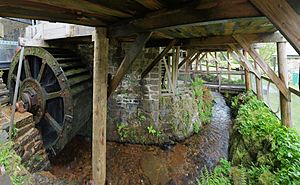Finch Foundry facts for kids
The Finch Foundry is a special place in Sticklepath, a small village in Devon, England. It's an old workshop that used the power of water to make tools. Back in the 1800s, it was known as Manor Mills. This foundry was very important for making tools used in farming and mining. At its busiest, it could make about 400 tools every single day!
William Finch started the foundry in 1814. His family, including Rebecca Finch, who was a great manager, ran the business for many years. The Finch family kept the foundry going until after the First World War. Later, in 1960, part of the building collapsed. Since 1994, the National Trust has owned and looked after it.
Today, the Finch Foundry is like a living museum. You can see amazing water-powered machines there, like the tilt hammer, drop hammer, and shear hammer. These machines were used to shape and cut metal. The National Trust keeps them working, and you can even watch demonstrations to see how they made tools long ago!
History of the Foundry
The Finch Foundry has a long and interesting past. Before William Finch started it in 1814, it was operated by John Browning and John Stanbury in 1805. William Finch first rented the workshop from John Stanbury.
The Finch family ran the foundry for many generations. After the First World War, three Finch brothers – Albany, James, and Thomas – bought the property. They wanted to make the business even bigger. They managed to keep it going even through tough times in the 1930s.
After Albany Finch passed away in 1945, the family business became a company. It continued until 1960, when a wall of the foundry fell down.
A Museum Idea
After the wall collapsed in 1960, a man named Richard Barron bought the foundry. He had a dream to turn it into a museum about old rural industries. Sadly, he passed away in 1964 before he could finish his plan. However, the people who took care of the Finch Foundry after him continued his idea. They worked hard to create the Rural Industrial Museum that you can visit today.
Gallery
External links
- Finch Foundry information, National Trust





